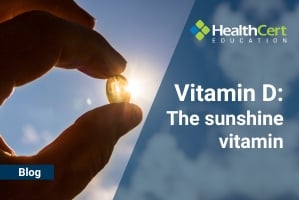Vitamin D: The sunshine vitamin
Primary care physicians are well positioned to advise patients on vitamin D supplementation, medical nutrition, and sun exposure practices.

HealthCert Education
Did you know that 1 in 3 Australian adults have inadequate levels of vitamin D (1)? Vitamin D is considered the ''sunshine vitamin'' because our bodies produce it after sun exposure, specifically to UVB light (2). It plays a role in hormone regulation; supports healthy immune function; and regulates the absorption of calcium for the growth and development of strong bones and teeth (3).
Learn more about vitamin D in the HealthCert Professional Diploma program in Medical Nutrition Management – online nutrition training for GPs.
Vitamin D deficiency
In winter, when our skin is covered and more often indoors, vitamin D is particularly important as many of us can become deficient. People who cannot tolerate or do not eat milk, eggs, and fish, such as those with a lactose intolerance or who follow a vegan diet, are at higher risk for a deficiency.
While regular testing isn't recommended for the general population, it is recommended for certain patient populations, including:
- Patients with inflammatory bowel disease (ulcerative colitis, Crohn's disease) or other conditions that disrupt the normal digestion of fat. Vitamin D is a fat-soluble vitamin that depends on the gut's ability to absorb dietary fat.
- Patients who are obese tend to have lower blood vitamin D levels. Vitamin D accumulates in excess fat tissues but is not easily available for use by the body when needed. Higher doses of vitamin D supplementation may be needed to achieve a desirable blood level. Conversely, blood levels of vitamin D rise when obese people lose weight.
- Patients who have undergone gastric bypass surgery, which typically removes the upper part of the small intestine where vitamin D is absorbed.
Vitamin D deficiency can contribute to bone loss (3), cancer, cardiovascular disease (4), frequent infections or illness (5), depression (6), metabolic health (7), hair loss, fertility (8), and other symptoms.
Primary care physicians are well positioned to provide patients with advice on vitamin D supplementation, medical nutrition therapy, and sun exposure practices.
Best sources of vitamin D
For patients with low bone mass, existing vitamin D deficiency, or who follow certain lifestyles (for example vegans, indoor or office workers (9)), supplementation may be an effective strategy, but optimal levels remain unclear (10). Vitamin D can also be obtained from certain foods.
The best dietary sources of vitamin D are:
- fatty fish such as salmon, herring, sardines and mackerel;
- eggs;
- mushrooms;
- fortified margarines; and
- fortified milk and yoghurt.
Fun fact: Mushrooms can be a good source of vitamin D as they increase their vitamin D production when exposed to UV light (11). A 2013 study showed that an hour in the direct midday winter sun stimulated the mushrooms to produce 10 mcg of D, the amount most adults need each day (12).
Key points
- Vitamin D is synthesised by the body when exposed to sunlight and is important for many metabolic and physiological functions including regulating calcium and phosphorous absorption.
- Combining evidence-based dietary strategies with sunlight or supplementation may significantly improve the vitamin D status of Australians as well as provide other important lifestyle benefits.
Learn more about vitamin D nutrition with the online HealthCert Professional Diploma program in Medical Nutrition Management.
– Lynette Law, Accredited Practising Dietitian
References
- Daly RM, Gagnon C, Lu ZX, Magliano DJ, Dunstan DW, Sikaris KA, et al. Prevalence of vitamin D deficiency and its determinants in Australian adults aged 25''�years and older: a national, population-based study. Clinical Endocrinology. 2012;77(1):26-35.
- Nowson CA, McGrath JJ, Ebeling PR, Haikerwal A, Daly RM, Sanders KM, et al. Vitamin D and health in adults in Australia and New Zealand: a position statement. Med J Aust. 2012;196(11):686-7.
- Fleet JC. The role of vitamin D in the endocrinology controlling calcium homeostasis. Mol Cell Endocrinol. 2017;453:36-45.
- Kheiri B, Abdalla A, Osman M, Ahmed S, Hassan M, Bachuwa G. Vitamin D deficiency and risk of cardiovascular diseases: a narrative review. Clin Hypertens. 2018;24:9.
- Aranow C. Vitamin D and the immune system. J Investig Med. 2011;59(6):881-6.
- Lerner PP, Sharony L, Miodownik C. Association between mental disorders, cognitive disturbances and vitamin D serum level: Current state. Clin Nutr ESPEN. 2018;23:89-102.
- Palaniswamy S, Williams D, Järvelin MR, Sebert S. Vitamin D and the Promotion of Long-Term Metabolic Health from a Programming Perspective. Nutr Metab Insights. 2015;8(Suppl 1):11-21.
- Pilz S, Zittermann A, Obeid R, Hahn A, Pludowski P, Trummer C, et al. The Role of Vitamin D in Fertility and during Pregnancy and Lactation: A Review of Clinical Data. Int J Environ Res Public Health. 2018;15(10).
- Fayet-Moore F, Brock KE, Wright J, Ridges L, Small P, Seibel MJ, et al. Determinants of vitamin D status of healthy office workers in Sydney, Australia. J Steroid Biochem Mol Biol. 2019;189:127-34.
- What is the optimal level of vitamin D? Australian Journal for General Practitioners. 2014;43:119-22.
- Cashman KD, Kiely M, Seamans KM, Urbain P. Effect of Ultraviolet Light-Exposed Mushrooms on Vitamin D Status: Liquid Chromatography-Tandem Mass Spectrometry Reanalysis of Biobanked Sera from a Randomized Controlled Trial and a Systematic Review plus Meta-Analysis. J Nutr. 2016;146(3):565-75.
- Cardwell G, Bornman JF, James AP, Black LJ. A Review of Mushrooms as a Potential Source of Dietary Vitamin D. Nutrients. 2018;10(10).

 1800 867 1390
1800 867 1390-1.jpg)
-1.jpg)
.jpg)



